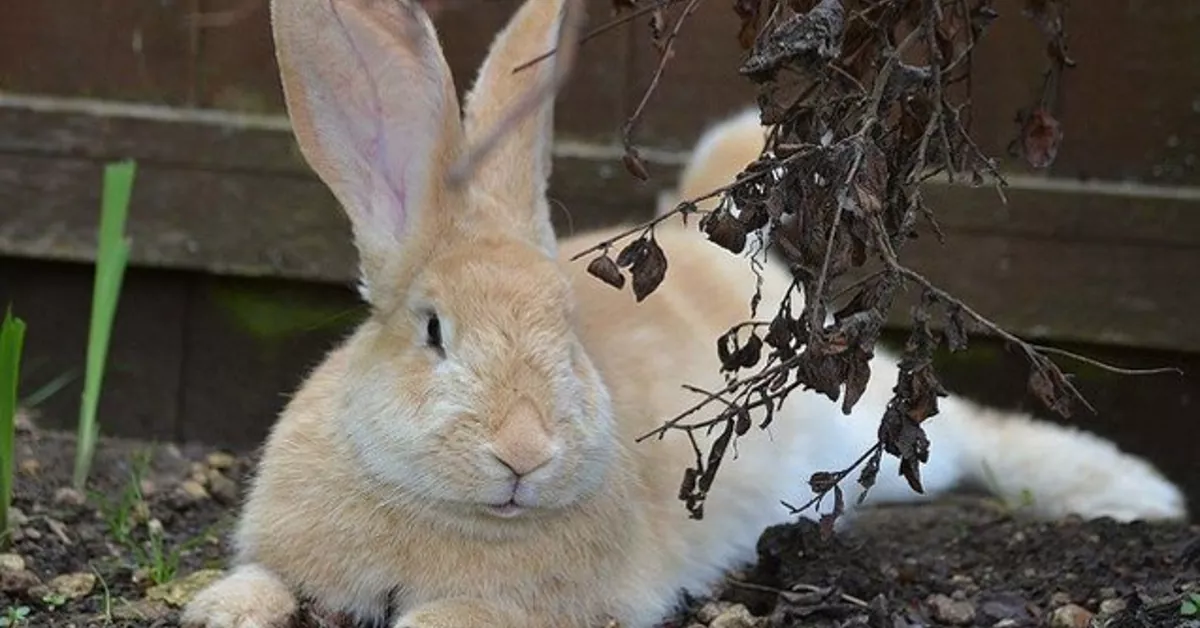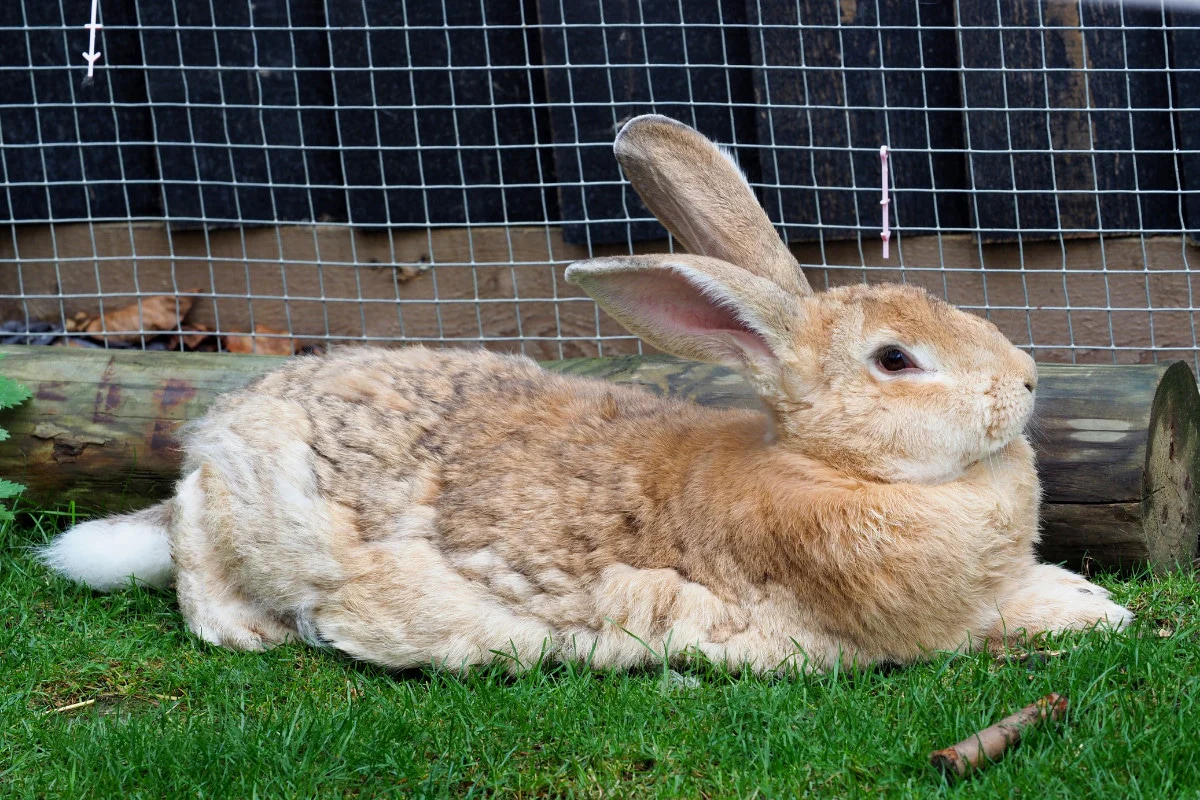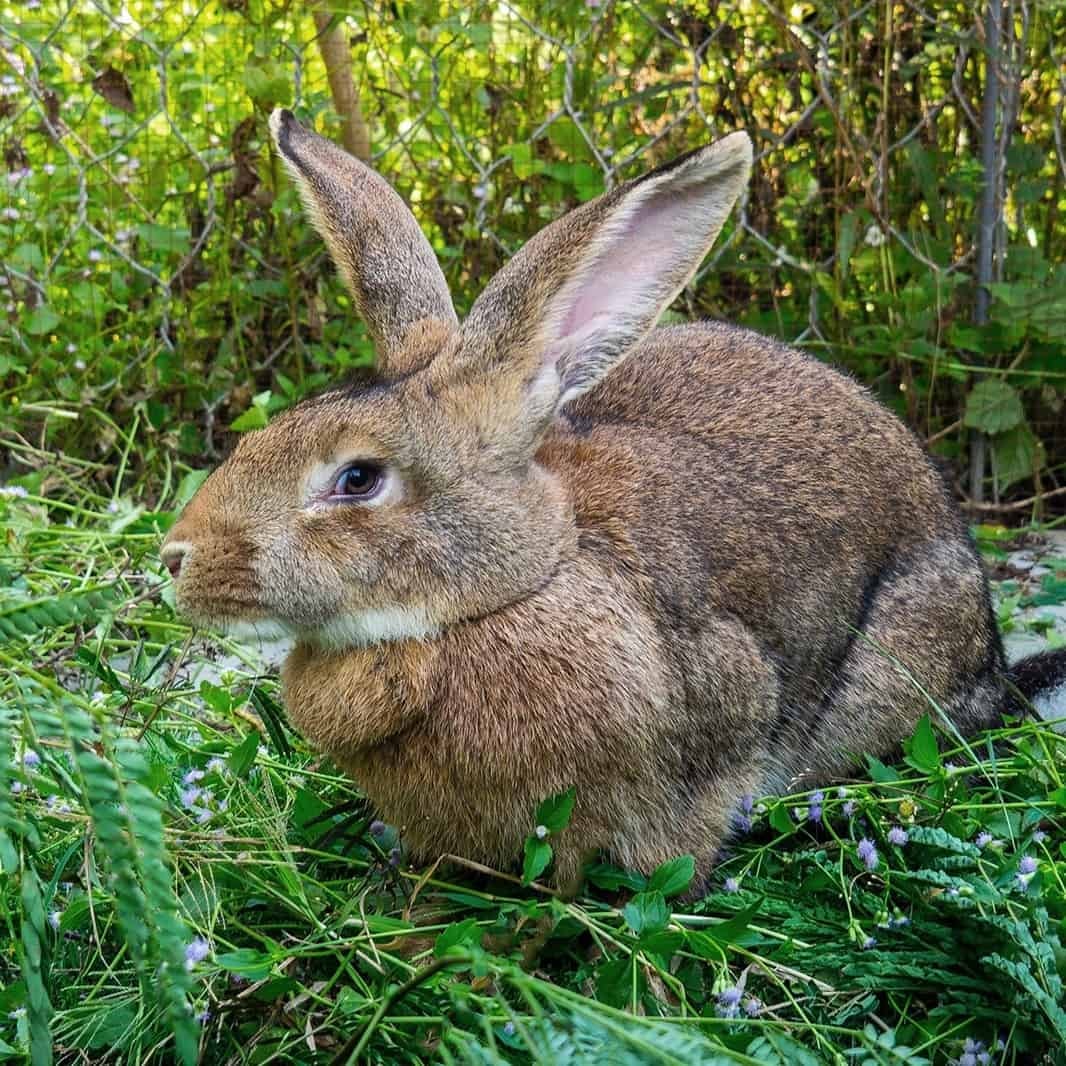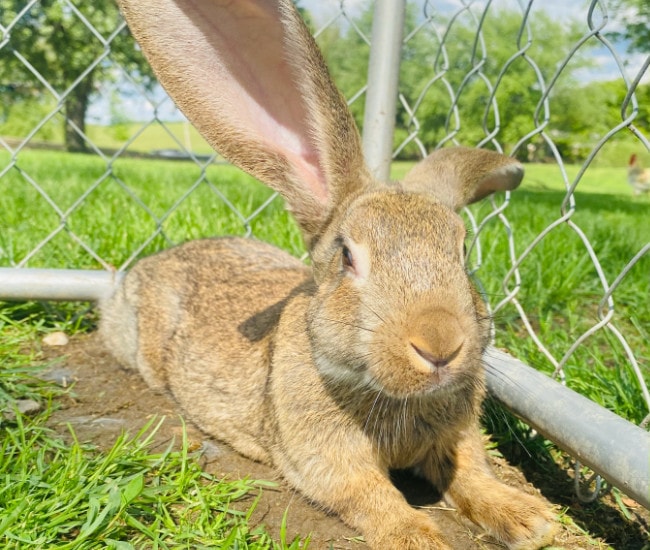Are giant rabbits good pets? These charming, oversized bunnies are undeniably captivating with their soft fur and affectionate nature. Their calm demeanor often makes them seem like the perfect companions for families and animal lovers. However, owning a giant rabbit is not as simple as it might appear. Their size alone brings unique challenges, from finding enough space to accommodate them to meeting their dietary needs. Understanding their specific care requirements is key to ensuring a happy life for both the rabbit and its owner.
Before you decide to bring one of these gentle giants into your home, it’s crucial to weigh the pros and cons. Giant rabbits can be incredibly rewarding pets for those prepared to meet their demands, but they are not for everyone. In this article, we’ll explore the characteristics, care requirements, and potential challenges of owning a giant rabbit, helping you determine if one of these adorable creatures is the right fit for your household.
The Joys and Challenges of Owning a Giant Rabbit

Giant rabbits can make great pets for the right people. These large bunnies, like Flemish Giants, are gentle and loving. They need more space and food than smaller rabbits. Giant rabbits are good pets if you can meet their unique needs.
Having a giant rabbit as a pet is fun but also a big job. You’ll need to give them lots of attention and care. These bunnies can be affectionate and social. They’re intelligent, too, so you can even train them. But remember, they live for many years, so it’s a long-term commitment.

Key Takeaways
- Giant rabbits require significantly more space and food than smaller breeds, making their care more demanding.
- These rabbits are affectionate, calm, and social, making them great pets for attentive owners.
- Owning a giant rabbit is a decade-long responsibility, requiring daily care and regular veterinary check-ups.
- A spacious enclosure and daily exercise are essential for their physical and mental well-being.
- Understanding the unique characteristics and needs of different giant rabbit breeds helps ensure a happy, healthy pet.

Understanding the Giant Rabbit Breed
Giant rabbit breeds are huge bunnies that can make unique pets. These big bunnies, like other giant rabbits, have interesting histories and special traits that set them apart from smaller rabbits.

History and Origin
Giant rabbit breeds have been around for a long time. Flemish Giants are one of the oldest and most well-known giant breeds. They came from Belgium in the 16th century. People first bred them for meat and fur.
Over time, people started to like these big bunnies as pets. They became popular in shows and as family pets because of their gentle nature.
Other giant breeds came later. Breeders mixed different rabbits to make new giant types. For example, the Checkered Giant came from mixing Flemish Giants with other breeds.
Defining ‘Giant’ in Rabbits
Giant rabbits are much bigger than regular rabbits. To be called a “giant,” a rabbit needs to weigh a certain amount. For example:
- Giant Angora rabbits must weigh at least 9.5 pounds for males and 10 pounds for females
- Some giant breeds can weigh up to 20 pounds or more.
Giant rabbits are also longer and taller than smaller breeds. They have big ears and strong bodies. Their size is what makes them stand out from other rabbits.
Popular Giant Rabbit Breeds
Several giant rabbit breeds are popular as pets. Each has its own unique looks and traits.
- Flemish Giant: Often called the “King of Rabbits,” they can weigh over 15 pounds. They have a gentle nature and come in many colors.
- Continental Giant: Similar to Flemish Giants, but can be even bigger. They’re known for being calm and friendly.
- Checkered Giant: They have white bodies with black spots. These rabbits are more active than some other giant breeds.
- French Lop: Known for their long, floppy ears. They’re big and have a sweet personality.
These gentle giants need more space and food than smaller rabbits. But many people love them for their size and friendly nature.
Check out this video showcasing the top 10 largest rabbit breeds.
By: Pets Life
Physical Characteristics of Giant Rabbits

Giant rabbits have some fantastic features that set them apart from other bunnies. You’ll be amazed at their impressive size and unique looks.
Size and Weight
Giant rabbits are big! Flemish Giants can weigh up to 15 pounds or more as adults. That’s about the size of a small dog. You might be surprised to learn that some giant rabbits can grow over 2 feet long. These bunnies grow quickly, too. By just 7 or 8 weeks old, they can already weigh 4 pounds.
When you see a giant rabbit, you’ll notice how much bigger they are than regular pet rabbits. Their large size means they need more space to live comfortably.
Distinctive Features
Giant rabbits have some eye-catching traits. You’ll notice their big, floppy ears right away. These ears can be up to 8 inches long!
Their fur is usually soft and thick. Many giant rabbits have a dewlap, which is a flap of skin under their chin. This feature is more common in females. Giant rabbits often have large, expressive eyes. Their noses are bigger, too, matching their overall size.
Breed-Specific Characteristics
Different giant rabbit breeds have their own unique looks. Flemish Giants, known as the “king of rabbits,” come in various colors like black, blue, and white. Continental Giants are similar but can be even larger. They often have a Roman nose, which is slightly arched.
French Lops are known for their extra-long ears that hang down past their face. They have a stocky build and come in many color patterns. Giant Angoras stand out with their long, fluffy fur. You’ll need to groom them often to keep their coat healthy.

Behavioral Traits and Temperament
Giant rabbits have a sweet and mellow personality. They make great companions for people who want a calm pet.
Social and Friendly Nature
Flemish Giant rabbits are known for their gentle nature. These big bunnies love to be around people. You’ll find them eager to bond with you and your family.
They enjoy being petted and cuddled. Their calm temperament makes them great for relaxing with. You can easily train them to come when called or do simple tricks.
Giant rabbits are patient pets. This means you can spend lots of time with them without them getting stressed. They like to be near their owners and will often follow you around the house.
Interacting with Other Pets and Children
Giant rabbits can get along well with other pets. Their calm nature helps them fit in with dogs and cats. But you should always supervise meetings between different animals.
These rabbits are good with kids, too. Their gentle and docile nature makes them patient with children. But small kids might find them too big to handle safely.
You should teach children how to pick up and hold a giant rabbit properly. This keeps both the child and the rabbit safe. Your giant rabbit can become a beloved family pet with the right care.
Rabbit Care Essentials

Giant rabbits need special care to stay healthy and happy. You’ll need to focus on providing the right housing, food, exercise, and grooming for your big bunny friend.
Housing and Enclosures
Your giant rabbit needs a spacious home. Flemish Giant rabbits require more living space than smaller breeds. A large indoor cage or pen is best, at least 4 feet by 4 feet.
Ensure the enclosure has a solid bottom to protect your rabbit’s feet. Add soft bedding like hay or straw. Your rabbit also needs a hiding spot to feel safe.
For outdoor housing, choose a sturdy hutch raised off the ground. It should be predator-proof and weatherproof. Provide shade and protection from rain and wind.
Always give your rabbit time outside its enclosure to hop and explore. Rabbit-proof a room or use a playpen for supervised exercise time.

Diet and Nutrition
Feeding your giant rabbit the right diet is crucial. Their main food should be unlimited high-quality hay. This helps wear down their teeth and provides fiber for good digestion.
Offer a small amount of rabbit pellets daily. Choose pellets made for giant breeds. They have different nutritional needs than smaller rabbits. Give your rabbit fresh veggies every day. Good choices include:
- Leafy greens like romaine lettuce and kale
- Carrots (in moderation)
- Bell peppers
- Cucumber
Avoid sugary treats and human food. These can upset your rabbit’s tummy. Always provide fresh, clean water. Change it daily and clean the water bottle or bowl regularly.
Exercise and Stimulation
Giant rabbits need plenty of exercise to stay fit and happy. Let your bunny out of its cage for at least a few hours each day. Make sure the area is rabbit-proofed to keep your pet safe. Provide toys for mental stimulation. Rabbits love to chew, so give them safe items like:
- Willow balls
- Cardboard tubes
- Wooden chew toys
Spend time playing with your rabbit. They’re social animals and enjoy interacting with you. Try gentle games like rolling a ball for them to push. Create a digging box filled with shredded paper or soil. This lets your rabbit express natural behaviors.
Grooming and Hygiene
Giant rabbits need regular grooming to keep their coat healthy. Brush your rabbit at least once a week. During shedding seasons, you might need to brush daily. Trim your rabbit’s nails every 4-6 weeks. If you’re not comfortable doing this, ask a vet to show you how.
Check your rabbit’s ears weekly for signs of infection or mites. Clean them gently with a damp cloth if needed. Keep your rabbit’s living area clean. Spot-clean daily and do a deep clean weekly. This helps prevent health issues and keeps your bunny comfortable.
Rabbits are usually good at grooming themselves. But if your giant rabbit gets dirty, you can give them a spot bath. Use lukewarm water and rabbit-safe shampoo.

Did You Know?
Giant rabbits require special care compared to smaller breeds. They need larger cages, more food, and additional grooming to stay healthy. Their large size also makes them more prone to specific health issues. Regular veterinary check-ups are essential to identify and address any potential problems early.
Health and Wellness
Giant rabbits need special care to stay happy and healthy. Knowing about common issues and regular check-ups can help you keep your big bunny in top shape.
Common Health Issues
Flemish Giant rabbits are usually healthy, but they can face some problems. One issue to watch for is sore hocks, also called pododermatitis. This happens when their feet get hurt from hard floors. To prevent it, give your rabbit soft bedding and clean surfaces.
Obesity is another concern for big bunnies. They love to eat, so you need to watch their diet. Too much weight can lead to other health issues. Giant rabbits can also get ear mites or dental problems. Keep an eye out for head shaking or drooling. These might be signs your pet needs a vet visit.
Veterinary Check-ups
Regular vet visits are key for your giant rabbit’s health. Find a vet who knows about big bunnies. They should check your pet at least once a year. During check-ups, the vet will:
- Look at your rabbit’s teeth
- Check for signs of illness.
- Trim nails if needed.
- Give any needed shots.
These visits help catch problems early. This can save you money and keep your rabbit feeling good.
Prevention and Care
You can do a lot at home to keep your giant rabbit healthy. Here are some tips:
- Brush your rabbit often to prevent matted fur
- Trim nails regularly
- Provide plenty of hay for good digestion.
- Give fresh veggies and clean water daily.
- Let your rabbit exercise in a safe space.
Watch for changes in eating, pooping, or behavior. These could be signs your rabbit isn’t feeling well. If you notice anything off, call your vet. With good care, your giant rabbit can live a long, healthy life. Pay attention to their needs and give them lots of love.
Training and Behavior Management
Giant rabbits can learn tricks and good habits with patience and practice. You can teach them to use a litter box and get along with people and other pets.
Litter Training Basics
Litter training your giant rabbit makes keeping their space clean much easier. Start by picking a big litter box that fits your rabbit’s size. Put it in a corner where your bunny likes to go potty.
Use rabbit-safe litter and add some hay on top. Place a few droppings in the box to show your rabbit where to go. Reward them with treats when they use them right. Be patient and consistent. Clean accidents without scolding. Your rabbit will catch on quickly with positive reinforcement.
Socialization Techniques
Help your giant rabbit feel comfy around people and other pets. Start slow and let them come to you. Sit on the floor and offer treats to build trust. Pet your rabbit gently and talk softly. Let them sniff and explore at their own pace. Have friends visit to get your bunny used to new people.
For other pets, supervise all meetings. Keep dogs on a leash and cats in a carrier at first. Reward everyone for calm behavior. With time and care, your giant rabbit can become a social butterfly!
Considerations Before Adopting
Giant rabbits can make wonderful pets, but they need special care. Before you bring one home, think about these key factors. They’ll help you decide if a giant rabbit is right for you.
Long-Term Commitment
Giant rabbits can live 8-10 years or more. This means you’ll care for your fuzzy friend for a long time. Are you ready for that? These friendly pets need daily attention. You’ll need to feed them, clean their cage, and give them exercise.
They also need regular vet check-ups. This helps keep them healthy as they age. Think about your future plans. Will you be able to care for a rabbit for its whole life? If you move, can you take it with you?
Space Requirements
Giant rabbits need lots of room. They’re much bigger than other pet rabbits. You’ll need a large cage or enclosure. It should be at least 4 feet by 2 feet for one rabbit. Bigger is always better!
They also need space to hop and play outside their cage. A rabbit-proof room or outdoor run is great. Can your home fit a giant rabbit comfortably? Do you have space for all their supplies, too?
Financial Responsibilities
Caring for a giant rabbit can be expensive. Here are some costs to think about:
- Initial Adoption Fee: $50-$100+
- Cage and Supplies: $200-$300
- Food: $30-$50 per month
- Vet Care: $100-$200+ per year
You might also need to pay for:
- Spaying/neutering
- Unexpected medical issues
- Rabbit-sitter when you’re away
Can you fit these costs into your budget? Remember, giant rabbits need care for many years. Make sure you’re financially ready for the long haul.
Connecting with Rabbit Communities

Joining rabbit communities can help you learn more about giant rabbits and connect with other owners. You’ll find support, advice, and friendship through these groups.
Support Networks and Forums
Rabbit enthusiasts often gather online to share tips and experiences. You can find forums dedicated to giant rabbit breeds where you can ask questions and get answers from experienced owners.
Look for social media groups focused on Flemish Giants or other large rabbit breeds. These platforms let you share photos, stories, and connect with fellow rabbit lovers. Don’t forget about local pet stores or veterinary clinics. They might host rabbit meetups or know of nearby groups you can join.
Local and Online Rabbit Clubs
Many cities have rabbit clubs where members meet regularly to discuss care, breeding, and showing rabbits. These clubs often welcome new members and can be a great way to learn hands-on about giant rabbits.
You can find online rabbit clubs that focus on specific breeds or rabbit care in general. These groups may offer:
- Virtual events and webinars
- Breed-specific information
- Show calendars
- Care guides for giant rabbits
Joining these clubs can help you stay up-to-date on the latest rabbit care practices and connect with other giant rabbit owners near you.
Check out this video on everything you need to know about owning a Flemish Giant Rabbit.
By: The Wild Side with Clay
Summary and Final Thoughts
Giant rabbits can make great pets for the right people. They’re gentle and intelligent, which you might love. But remember, they need lots of space and care. You’ll need to think about their size. Giant rabbits are much bigger than regular bunnies. This means they eat more and need bigger cages.

Flemish Giants are social and like to be around you. They can be as fun as dogs or cats. But they live shorter lives than smaller rabbits. Caring for a giant rabbit costs more. You might spend up to $1200 a year on food and supplies. That’s more than for a small rabbit.
If you have time, space, and money, a giant rabbit could be perfect for you. They’re calm and loving pets. But they’re not for everyone. Think about your lifestyle. Can you give a giant rabbit what it needs? If yes, you might find a wonderful new friend in one of these big bunnies.
Frequently Asked Questions
Giant rabbits make unique pets with specific needs. Here are answers to common questions about caring for these large bunnies.
How Much Space Do I Need to Keep a Giant Rabbit as a Pet?
Giant rabbits need lots of room to hop and play. You should have a cage or kennel with at least 24 by 36 inches of floor space. The cage height should be at least 14 inches. An outdoor hutch with a play area is even better. Your giant bunny will love having space to stretch its legs.
What is the Lifespan of a Giant Rabbit When Kept as a Pet?
With good care, your giant rabbit can live 5-8 years. Some may even reach 10 years old. Proper diet, exercise, and vet check-ups help your furry friend live a long, healthy life.
Can Giant Rabbits Be Suitable Pets for Families With Children?
Giant rabbits can be great family pets, but caution is needed with young kids. These rabbits are gentle and friendly, making them good companions. For safety, it’s best to wait until children are over 6 years old. The rabbit’s large size can be hard for little ones to handle.
What Are the Dietary Requirements of a Giant Rabbit?
Your giant rabbit needs a diet high in fiber. Give them unlimited hay, fresh veggies, and a small amount of pellets. Clean water should always be available. Treats like fruits can be given in small amounts as rewards.
What is the General Temperament of Giant Rabbits?
Giant rabbits are often called “gentle giants.” They’re usually calm, friendly, and easy-going. These bunnies enjoy human company and can be quite affectionate. With proper handling, they make excellent, docile pets.
Connect with Us on Social Media and Spread the Bunny Joy!
Are you passionate about bunnies? We are, too, at The Rabbit Hop! Become part of our online community and enjoy:
Bunny Fun: Enjoy charming videos, discover interesting facts, and get tips for keeping your bunny happy!
Product Recommendations: Find the highest-rated items ideal for your furry friend.
Bunny Network: Engage with fellow bunny lovers who share your enthusiasm.
Follow us on:



